Androgenetic Alopecia - Everything You Need To Know
Have you been experiencing excessive hair fall over a prolonged period of time? It could be an early sign of androgenetic alopecia. It is a hair loss disorder common in both genders and can lead to progressive thinning and even baldness in some patients if not caught and treated early.
Androgenetic alopecia affects about 50 million men and 30 million women in the US. In India, there's a 58% prevalence of AGA in males between the age of 30 to 50 whereas in oriental races this is much lesser. i.e 21.3% in Chinese and 14.3% in Korean men. The overall percentage of AGA prevalence is lesser in females with 19% in caucasian, 6.0% in Chinese, and 5.6% in Korean patients. In both genders, there is a gradual increase in the incidence of androgenetic alopecia with age. It is essential to better understand this condition, its causes, and early symptoms to catch it before it escalates. So, here is everything we believe you must know about androgenetic alopecia and how you can treat it
What is Androgenetic Alopecia?
Androgenetic alopecia is a disorder that leads to hair fall as a result of excessive response to androgens. It affects both men and women and is usually marked by progressive and patterned hair loss that starts anytime after puberty. The hair loss pattern is different for males and females. Where men experience an M-shaped receding hairline, with hair loss on the crown being most common, women often have thinning hair all over their head with more obvious loss at the crown and a widened center part.
Depending on each case, the reasons for androgenetic alopecia can vary from genetic predisposition, hypertension, insulin resistance, PCOS in women, etc.
Causes of Androgenetic Alopecia
Androgenetic alopecia can be caused due to different reasons for different people, with factors like genes or hormones and even the environment playing a contributory role. While there is still no clear evidence to isolate one explicit cause, several factors may contribute to these conditions. They are:

1. Hormones
Hormones called androgens play a big role in this type of hair loss. Androgens are hormones that are important for proper sexual development in males and other functions like regulation of hair growth and sex drive in both males and females. An androgen called dihydrotestosterone is responsible for androgenetic alopecia, which is more common in males than females, and so men are more prone to androgenetic alopecia. Increased levels of dihydrotestosterone can cause shorter hair cycles, delayed growth, and thinning hair strands over time, leading to hair fall, thinning, and even baldness.
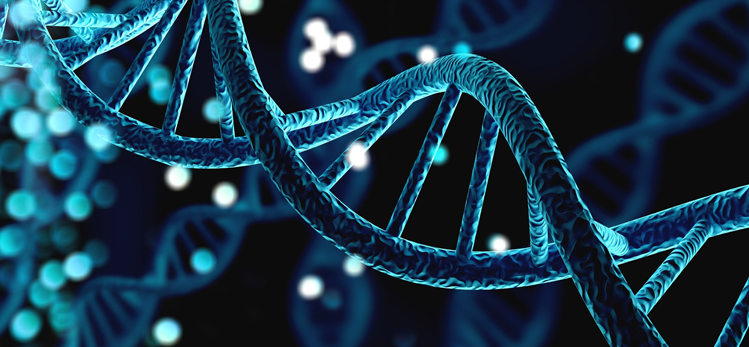
2. Genes
Genes are also known to be a cause of androgenetic alopecia. While there might be several genes at play, a variation in the AR gene has been confirmed to be a prerequisite to the early onset of androgenetic alopecia. These variations can lead to increased activity of androgen receptors in hair follicles and thus an overall disruption of a healthy hair cycle of an individual. Owing to this, it is often said that a genetic predisposition increases the risk of this type of hair loss.
3. Medical Conditons
Other medical conditions like coronary heart disease, prostate cancer in men, Polycystic ovarian syndrome in women, etc., may also be responsible for androgenetic alopecia. These disorders are also believed to be associated with hormones and androgens, and so there could be a link between these medical conditions and resulting hair loss.

The Scale of Androgenetic Alopecia
The extent of Androgenetic alopecia is often judged by comparing it to various scales. The Norwood-Hamilton scale is most commonly used for MPHL (Male pattern hair loss), the Ludwig Scale, and the Sinclair scale for female pattern hair loss.
The Norwood - Hamilton Scale: It is a grading scale for MPHL where men can easily determine the severity of the condition. This scale is used to determine the extent, type of hair loss, and viable treatment options for the condition. The scale has a total of 8 stages of hair loss with different extents of hair loss and balding.
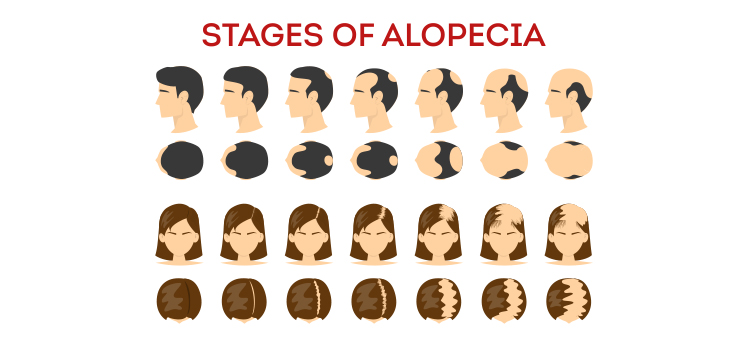
The Ludwig Scale: The Ludwig scale is one of the most commonly used ways to diagnose and determine the extent of FPHL. It illustrates the progression of hair loss in women in 3 stages and patterns. This scale is important to determine the extent of hair loss in women and decide your dermatologists viable treatment options.
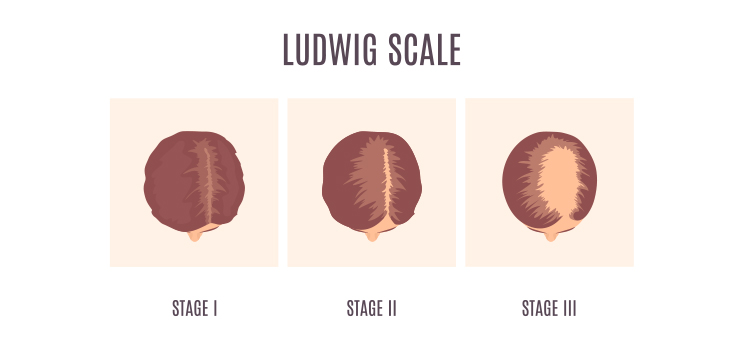
The Sinclair Scale: The Sinclair hair shedding scale is used to evaluate the extent and severity of hair shedding in women. It is divided into five stages with stage one being normal and stage five being advanced. It aids the dermatologist in creating a problem-specific treatment plan.
How to Treat Androgenetic Alopecia?
Early diagnosis may allow for controlling or treating androgenetic alopecia with better results. Here are some treatment options that can be used to treat androgenetic alopecia, the former two being pharmacological options and the latter, procedural options. Your dermatologist will guide you for appropriate option(s) after assessment.
1. Topical Minoxidil
Minoxidil is a prescribed medication approved by the CDSCO for treating androgenetic alopecia. It is used in a 2% and 5% solution. Minoxidil is known to work due to several factors. It improves the blood flow to the scalp, and that can lead to better hair growth. Minoxidil also opposes calcium entry to the cells; this, in turn, increases epidermal growth factors and improves overall hair growth. Minoxidil is applied topically and must be applied twice daily on the balding scalp. With the application of minoxidil, hair loss reduces, and some patients also observe newer hair growth. However, this treatment should be based on the dermatologists instructions and should be adhered to consistently for three to four months for visible results.
2. Finasteride
Another treatment option is the use of a 5AR inhibitor called Finasteride. It is an CDSCO-approved drug for the treatment of androgenetic alopecia. Finasteride inhibits type II 5AR, which leads to the conversion of testosterone into DHT. However, topical Finasteride may not be available in most countries.
Finasteride is a popular treatment choice for male pattern hair loss,where patients have vertex hair loss patterns rather than hairline loss. It is a prescribed medication and must be taken only as per the dermatologists instructions.
3. Low-level Laser Therapy
Low-level laser therapy is another treatment option for androgenetic alopecia. Low-level lasers are known to stimulate hair growth at certain wavelengths. There are many mechanisms to deliver this therapy, including a hood, a comb, a helmet, etc. Depending on the case, your doctor may prescribe low-level laser therapy and other drug therapies to treat this type of hair loss.
4. Microneedling
Microneedling as a treatment option has gained popularity in the recent past. This process stimulates hair regrowth in patients with alopecia. It was earlier used in various cosmetic procedures, but in treating androgenetic alopecia, microneedling helps in improving drug delivery. It is also used along with other therapies like minoxidil treatments and PRP, etc. Depending on each case, a doctor may prescribe you this treatment along with other drug and topical treatments.
Some of the most common and yet lesser-known outcomes of androgenetic alopecia are stress, anxiety, depression, and low self-esteem. Patients often have trouble accepting their new appearance, and it may affect other aspects of their life. In such cases, it is always better to seek emotional help along with your medical treatment for androgenetic alopecia.
Androgenetic alopecia may not be completely curable, but it can be controlled. Visit your dermatologist at the earliest if you see any of the symptoms associated with this condition. With proper diagnosis and a treatment plan specific to your situation, you will no longer have to worry about your beautiful tresses.
Myth Busters HairFall
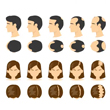
Androgenetic Alopecia - Everything You Need To Know
Have you been experiencing excessive hair fall over a prolonged period of time? It could be an early sign of androgenetic alopecia. It is a hair loss disorder common in both genders and can lead to progressive thinning and even baldness in some patients if not caught and treated early.

How To Make Hair Grow Faster For Men
A head full of healthy hair is a matter of confidence. Hair has its own mechanism of growing and shedding, and it is when this mechanism is thrown off that growth is hindered. Especially in the case of males, hair growth faces a lot of hiccups that can easily be managed.
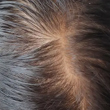
Female Pattern Baldness - Causes & Treatments
Have you suddenly noticed an increase in the number of hair strands on your pillow in the morning? Or is your ponytail getting thinner by day? Well, you might be suffering from female pattern baldness. While that does sound scary, identifying it early on is key to treating this condition effectively. So keep reading to know what this is, how you can identify it, and most importantly, what treatments you can avail of to get your beautiful lustrous hair back.
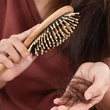
What Are The Reasons For Hairfall?
Almost everyone experiences some amount of hair thinning over the years. Shedding around 50 to 100 single strands of hair per day is considered normal. However, losing more than 150 strands a day, experiencing sudden thinning, or developing circular bald patches on your scalp are reasons for concern. Hair loss occurs when new hair doesn’t grow fast enough to replace the amount of hair you lose daily. Hair can fall due to various reasons, with hereditary hair loss and poor nutrition being the most common hair fall reasons.

Expert Approved Tips For Hair Growth
What can be more debilitating than seeing hundreds of hair strands shedding from your scalp every time you brush your hair? Also, excessive molting occurs during seasonal changes that can be very stressful for you. Although it’s okay to lose between 50-100 strands every day, according to the American Academy of Dermatology, the problem occurs when you start shedding more than normal. But that doesn’t mean you have to feel helpless as there are ways to grow your hair back. Even if you are coping with baldness or alopecia, certain hair growth tips from dermatologists can come to your rescue. Read on to discover how these tips can be your savior when abnormal hair fall problems are in sight.
Trending Videos
+ 15 Sources
'LMRC - GGI-CO-A2-DMA-300026127-300026127-WM-J21-282'
© 2021 Dr. Reddy’s Laboratories Ltd. All rights reserved.